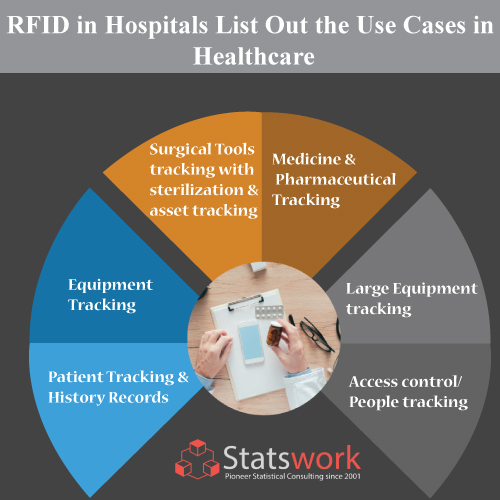RFID in hospitals – List out the use cases in healthcare.
In-Brief
- The use of RFID offers many benefits to the healthcare industry related to patient safety, tracking, efficiencies in patient care, and provider satisfaction.
- RFID in healthcare organization provides immediate or real-time tracking and management of staff across all types of patient care environments. This provides useful information when tracking productivity in a busy hospital and make a statistical analysis plan.
Introduction
The abbreviation of RFID is Radio Frequency Identification. This technology operates based on a tagging scheme. An object is marked with a special tag, which is followed by radio waves. Reader, Antenna, and Transponder are the three components of RFID.
The antenna transmits a radio-frequency signal that enables the RFID tag to communicate with it. As the RFID tag passes through the scanning antenna’s frequency region, it recognizes the activation signal and stores the data picked up by the antenna.
RFID technology is like barcode technology. The key difference between RFID and a barcode scanner is that RFID operates faster. Another distinction is that barcode scanners must be used to monitor information on a product or entity, while RFID uses radio waves to track product details.
- Patient Tracking and History Records
A patient’s wrist is girded with an RFID band. The hospital maintains track of the patient using RFID. The wristband contains all pertinent information, such as a person’s name, medical history, allergies, and so on.
When a patient has been hospitalized for an extended period, RFID will help the doctor decide to incase the patient is allergic or sensitive to any drugs. The patient’s medical history often aids surgery by supplying vital details.
The RFID tag may help cases where a patient’s memory is compromised and may wander or get lost in a hospital. The hospital will monitor the patient’s exact location using RFID wristbands.
- Equipment Tracking
Hospitals need to monitor their machines, supplies, and vehicles. It not only alerts them to the position of their cars, equipment, and other properties, but it also aids in asset maintenance.
Hospital assets are vital and must always be available for use. RFID tags are used to monitor assets as they travel across the hospital, both inside and outside.
When it comes to Operation Theatres, it is required that assets be inspected regularly to prevent unplanned breakdowns. When it comes to managing mission-critical assets, Asset Maintenance Management software comes in handy.
- Surgical Tools tracking with sterilization & asset tracking
Surgical instruments such as scissors, scalpels, clamps, and retractors are used regularly, so they must always be available, clean, disinfected, and ready to use. Unfortunately, the least dangerous condition created by not monitoring these tools is not getting the required surgical instruments on hand. Surgical instruments in hospitals are found to be carrying bacteria from previous use every year, according to reports, either because they were not sterilized or because they were not sterilized properly. Not only could using RFID tags to monitor these products ensure that each tool was sterilized before use, but a well-implemented system could also shed light on sterilization methods for specific tools.

On-metal RFID tags embedded in or added to surgical equipment enable them to be monitored for inventory purposes and ensure that they have passed through the autoclave’s disinfection process. A few different types of autoclaves use different sterilization methods; hospitals may ensure that all tools went through the manufacturer’s correct autoclave by monitoring each tool individually. It is worth noting that not all RFID tags can withstand the autoclave process, so pick one that can ensure that all equipment is thoroughly cleaned and sterile.
- Medicine & Therapeutic Tracking
Asset management and tracking software help handle the area of drugs in hospitals—the system data about the stock levels and expiry date of medicines. In general, the software also allows you to track the current stock of medicines easily.
Pharmaceuticals in hospitals can be tracked and handled using asset monitoring and management software. The device keeps track of prescription expiration dates and stock levels. Overall, the app makes it simple to keep track of your current medication stock.
Medicines and surgical instruments are both costly products. As a result, healthcare facilities need to keep inventory and track of these products. The investment is important, and it cannot be safeguarded without monitoring.
- Large Equipment tracking
Medicines and surgical instruments are both costly products. As a result, healthcare facilities need to keep inventory and track of these products. The investment is important, and it cannot be safeguarded without monitoring. Using an RFID system is the ultimate way to keep tracking of these assets within the building.
Hospitals usually use an active RFID Real-Time Location System (RTLS) to know where these assets are always if an RFID system is deployed due to these assets’ costly and sensitive existence. Some hospitals set up their systems to only read specific areas or offices, while others set them up to read entire hallways or floors. Statistical analysis help RFID systems to monitoring vehicle ingress/egress in warehouse environments.
- Access control/People tracking.
Security is another element of people monitoring that hospitals use to discourage people from roaming around the facility by limiting access to certain rooms or areas. To gain access to this device, employees must wave or tap their RFID-enabled badges in front of door readers. It not only prevents unauthorized access to restricted areas but also ensures that patients, medications, and medical equipment are safe from theft or injury.
Conclusion
RFID innovation has a lot of potentials to assist in the medical services of hospitals. Moreover, the system opens new doors for enhanced security, operational effectiveness, and cost savings by tagging stocks, assets, patient data, and personnel records.
Even though RFID guarantees several advantages for the hospital sector, RFID innovation’s adoption has not been as striking as envisioned. Still, it falls behind when contrasted among different industries. Stats work also provides Statistical analysis Services for healthcare sectors.
References
- Fuhrer, P., & Guinard, D. (2006). Building a smart hospital using RFID technologies: use cases and implementation. Fribourg, Switzerland: Department of Informatics-University of Fribourg.
- Lahtela, A., Hassinen, M., & Jylha, V. (2008, February). RFID and NFC in healthcare: Safety of hospitals medication care. In 2008 Second International Conference on Pervasive Computing Technologies for Healthcare (pp. 241-244). IEEE.



 Next Post
Next Post